How Doth the Little Crocodile...
⬅ previous ⬆intro next ➡Day 8 ~ January 27 ~ Nile

Morning, and we come ashore to the island village of Bisaw
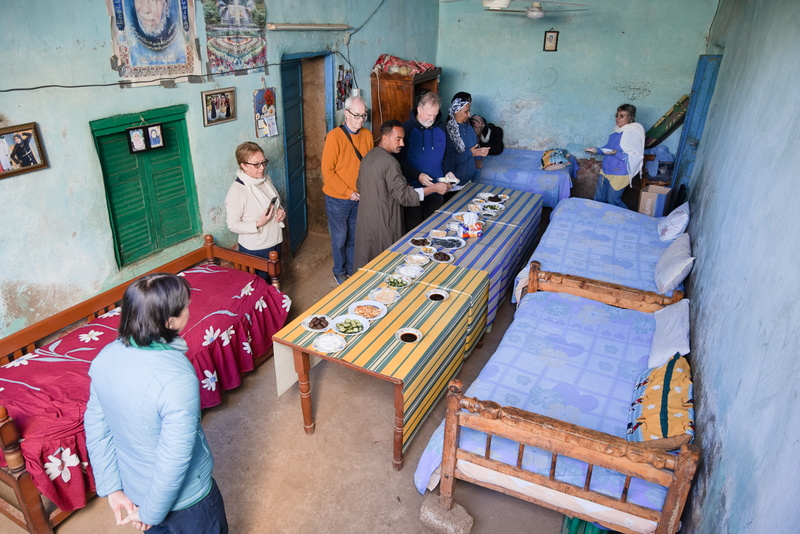
A village family invites us to breakfast.

It's quite a spread!
Amanda and I will go easy on the cucumber (as some of you will know, we share a bemused incomprehension as to what the world sees in cucumber, but hey, we're not going to make a scene about it). Everything else is yummy, although if you're vegan and gluten-free, you'd be a bit stuffed once the bread, cheese and eggs were taken away. (I wouldn't want to be too sure of the ideological purity of the hummus and falafels even.) Fortunately, we are not chicken and have no beef with the domestication of Triticum, Bos and Gallus species.
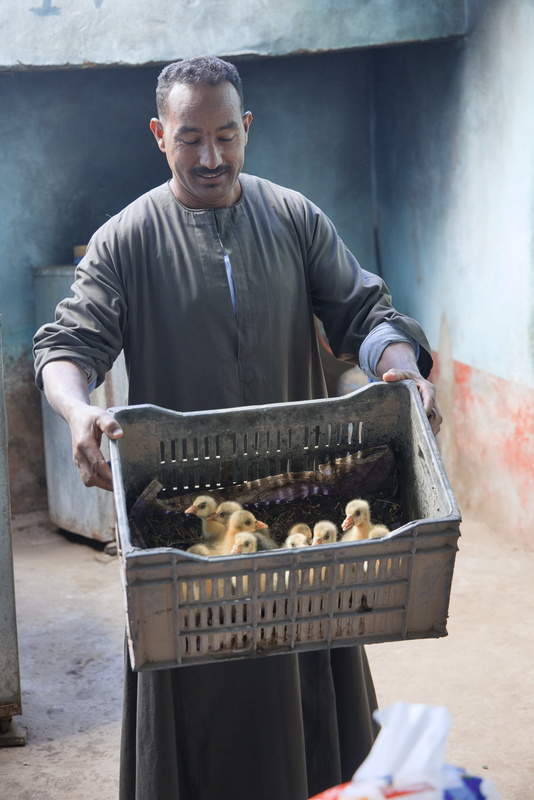
The farmer shows us some of his baby chicks.
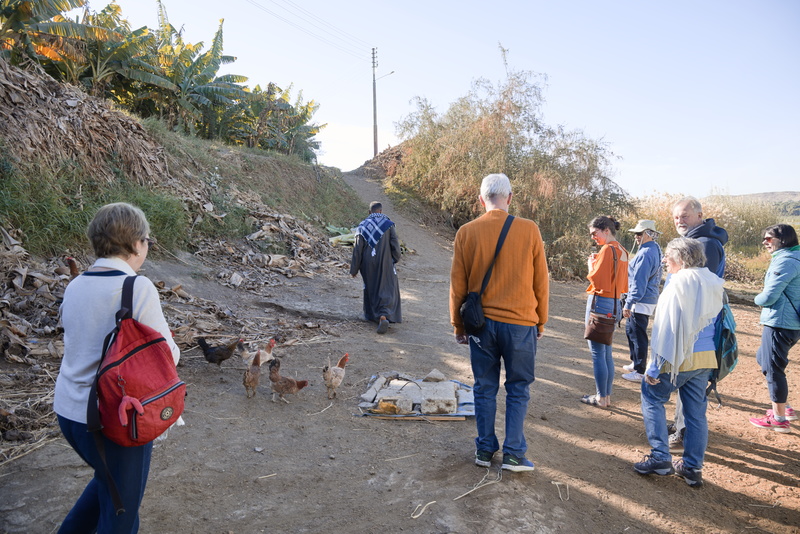
Then we set off for a walk, followed by more grown-up chickens for a moment.
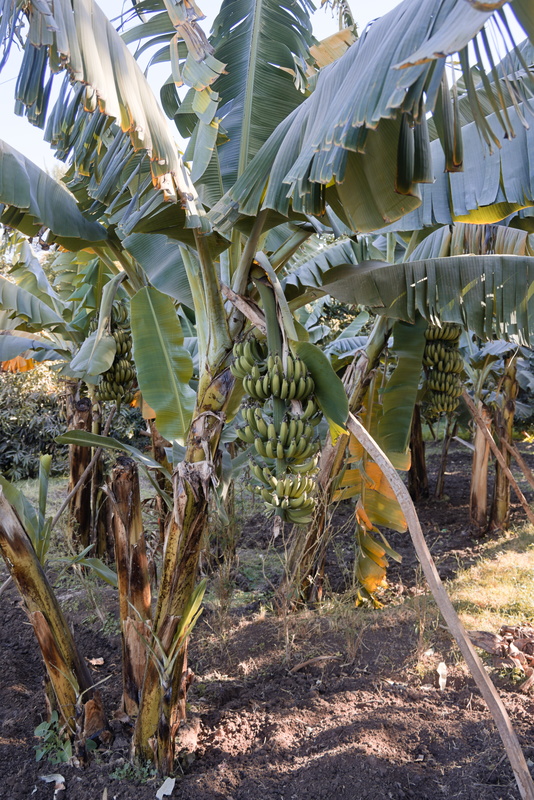
Bananas are a local crop. I don't t think these are Cavendishes -- the overwhelmingly dominant commercial variety worldwide -- because they look a bit small for that, but I'm not sufficiently expert a bananologist to say for sure.
Interestingly, there appears to be no actual word for an expert on bananas, or one who studies them. Is this because too few people engage in such a task to warrant a special name, or because neither the Greeks nor the Romans knew this (not exactly) fruit and so we can't have a proper scientific word derived from those languages. The logical extrapolation from the genus name, Musa, would be 'musaologist', but apart from one slightly tongue-in-cheek Google hit, I can't find evidence of this being a real thing. For your reference, this ProMusa blog post says, "Finding out at the age of 13 that the banana plant is a giant herb sent Gabriel Sachter-Smith on a quest to learn everything he could about bananas [...] The self-described 'Musaologist'". So there, there's one person who's travelled the same linguistic path that I have, but he appears to be unique. Other references mostly seem to be typos for 'museologist', which is also a bit of a thing in Egypt, but completely different.

The water from this pump is no longer used for drinking, as a treatment plant now purifies water taken directly from the Nile. It's far from redundant, though, being just outside the village mosque and therefore perfect for washing before prayers. And for those who think that everything in the universe is connected to everything else, it will be no coincidence that I'm writing this on the first day of Ramadan.

A rare sight in modern Britain: kids playing in the trees!
Now don't get me wrong: I am not for one microsecond the sort of person who thinks that everything today is rubbish and the past was so much better. No, it's swings and roundabouts, but I do think the relative lack of freedom that kids today have to be kids is one of the backward swings.
Anyway, the next point on our walk is the village bakery.
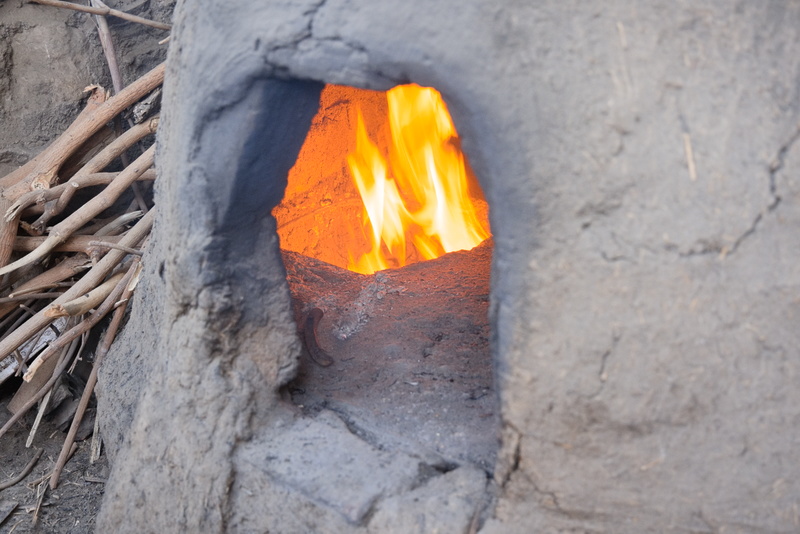
"Preheat your oven to... err... well... hot."
I am not quite so back-to-basics myself, but I do confess that our two ovens at home have between them approximately 47 million programmable features that I never use and probably never will. And remember, my day job is programming! (I sometimes say to friends struggling with their high-tech devices, "The reason this makes no sense to you is because it was designed by somebody like me". On behalf of my entire industry: sorry.)
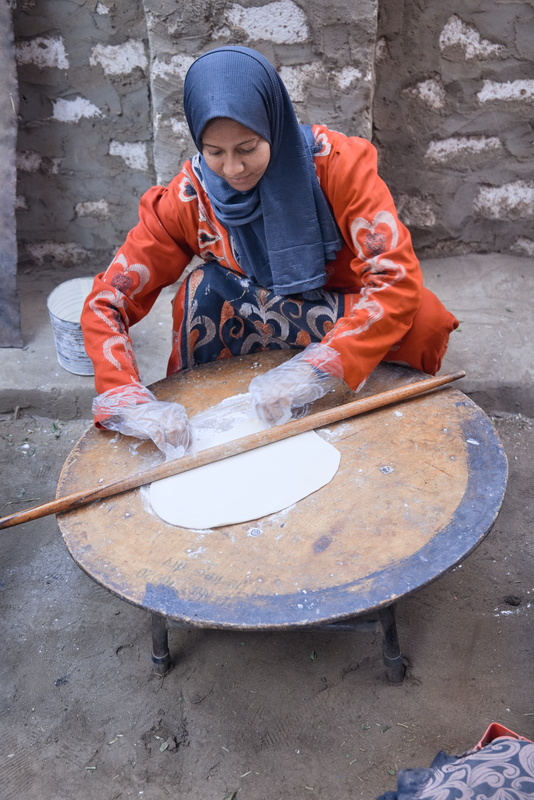
A master at work.
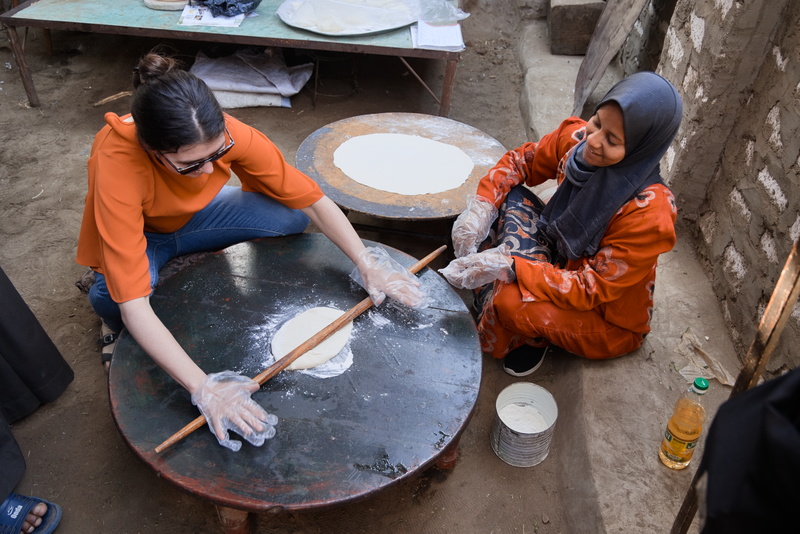
And the apprentice.
To save Sophie's blushes, I won't show the final stage of her rolling, but it's not quite as evenly circular as the one behind her. Fortunately, the thin sheet will be folded over on itself before baking, so perfection isn't strictly necessary.
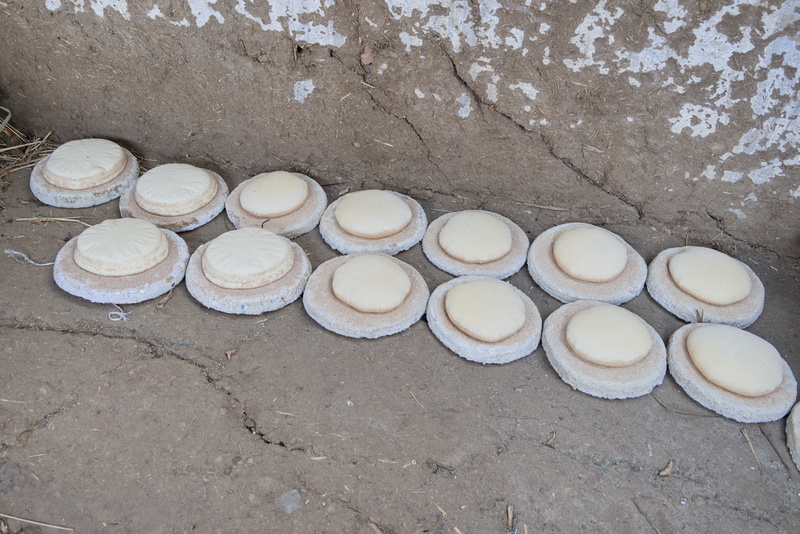
The non-flat bread has been prepared earlier and left to rise, so we can't have a go at making that.
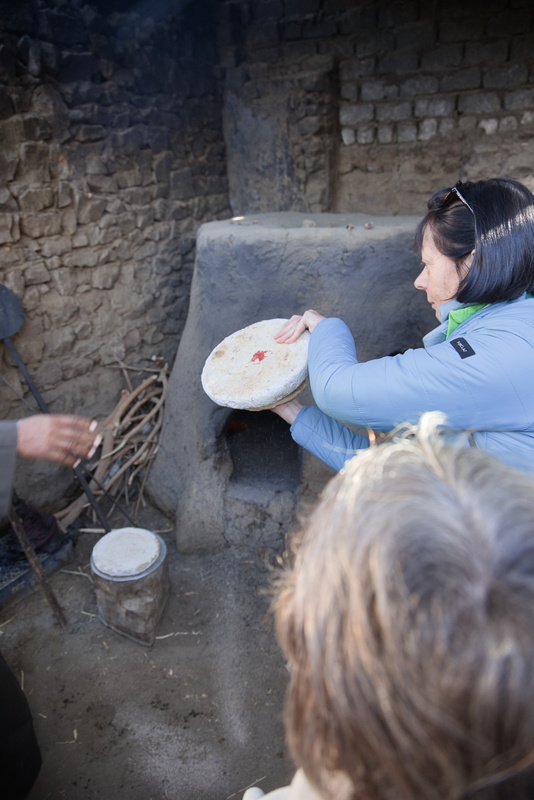
Instead, Amanda learns the technique of flipping it over to remove it from its base ready to be put in the oven.

And in it goes.
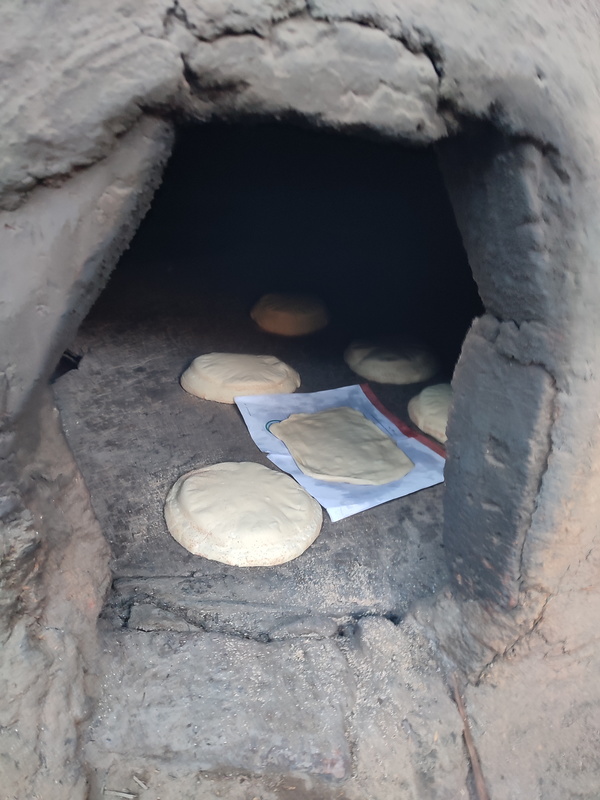
I do likewise, and Sophie does her flatbread, and they all start to bake away. Note how the furthest one back (that has been in the longest) is already starting to brown. I don't know the temperature of this one, but wood-fired ovens generally start at "very hot" by domestic kitchen standards and go up from there. For classic pizza, you want 400-450 C, which is just absurd if you look at what your home oven is limited to.
And having alluded to Islam earlier, I must redress the balance and allude to Christianity: we've done the loaves, we need some fishes!
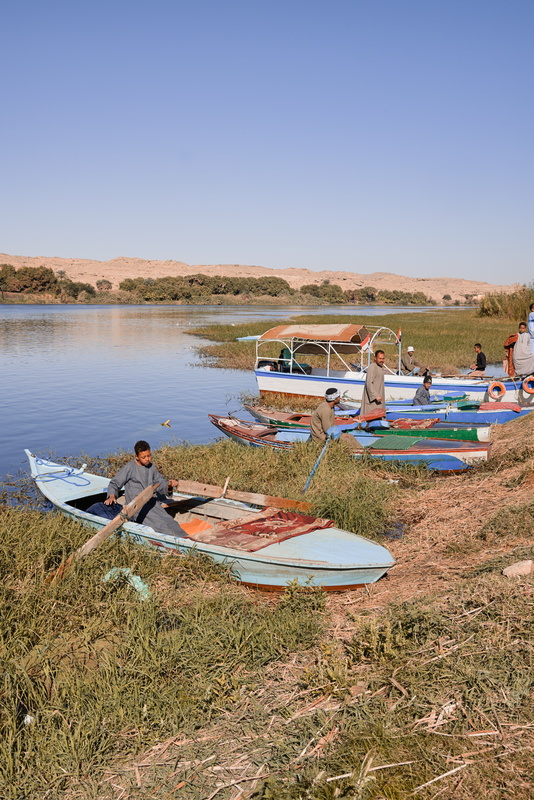
We're going to go out on these small boats that are used for fishing. We won't be doing the fishing ourselves, just observing it.

Lifejackets required for the tourists. Nothing so silly for the locals. Amanda and I wouldn't bother if it was just down to us, either, but no big deal.
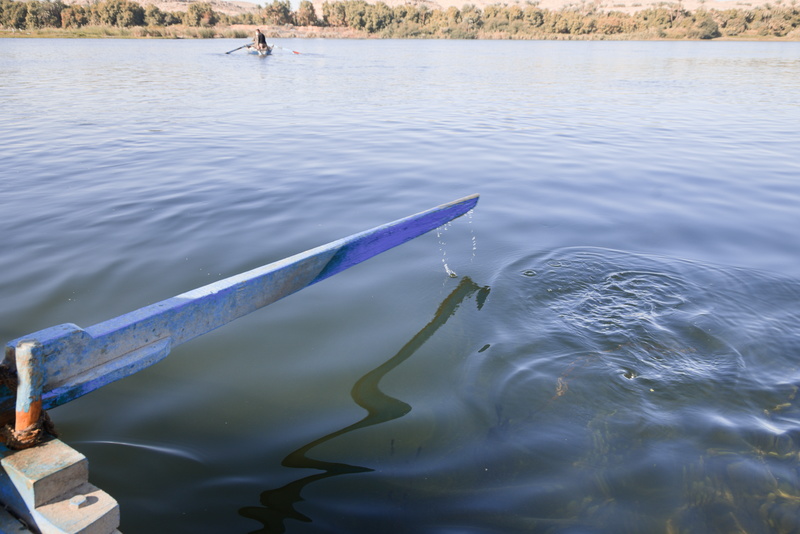
The oars are interesting: flat, slightly tapered blades the whole length rather than our normal pole/blade design. I suspect the latter is more efficient but more work to make and maintain, and when you only need to get out into the middle of the river and back, hydrodynamic perfection is mostly wasted.

The fisherfolk pay out their net, curling round in big loops. While over the years we have sometimes felt that demonstrations of 'traditional' techniques have been mostly for the tourists, we've seen this happening elsewhere on the river already.
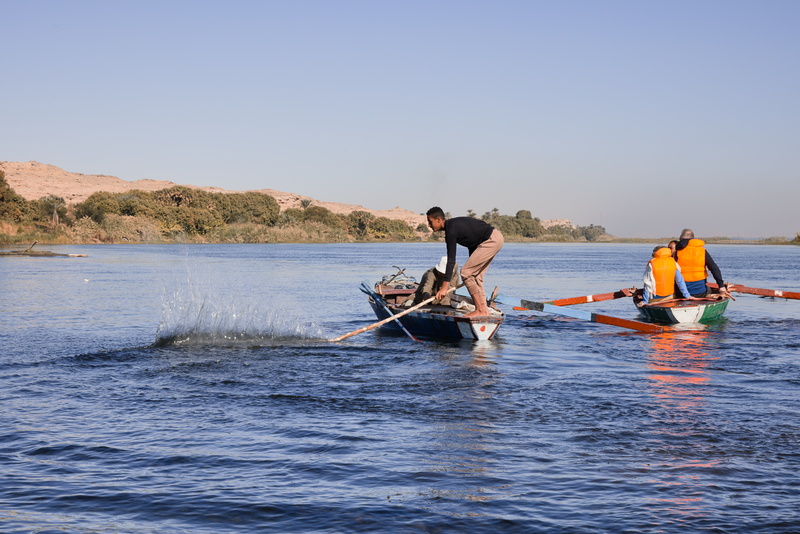
Now you hit the surface of the water with a big stick to startle the fish and make them scatter, hopefully into your net.
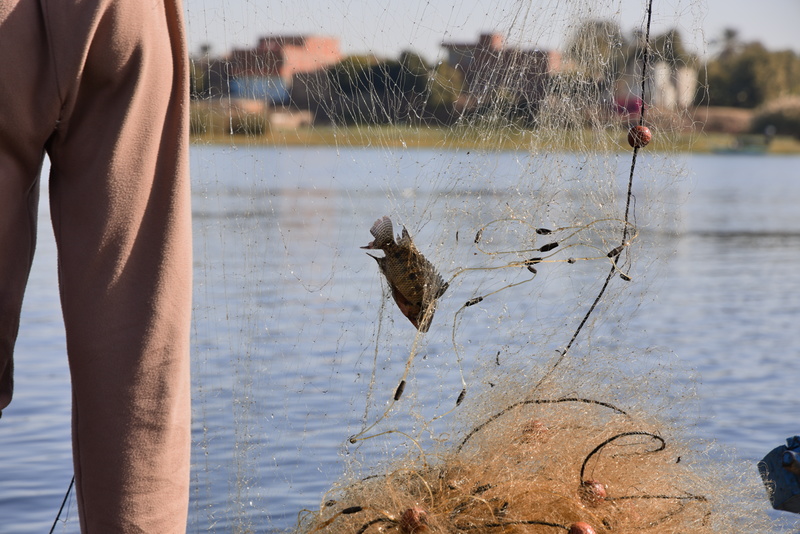
And it works.

Back on shore, I am proud to assume the key role of fishbag-wallah, to take our catch back to the boat.
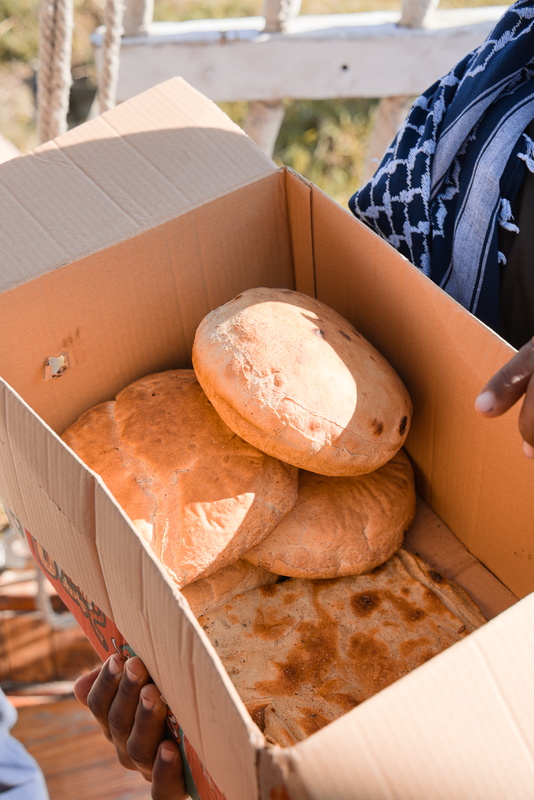
Oh, and here's our bread too.
Back to the boat and a bit more sailing...

We tie up at Silsila, an ancient quarry and the location of the Temple of Horemheb.
Horemheb was the last Pharoah of the 18th Dynasty, having achieved that status through the combination of being Commander-in-Chief for his predecessors Tutankhamun and Ay (who may have really been in charge even when the young boy Tutankhamun was nominally the Pharoah), and marrying into the right family. Plus ça change, eh?
We're mainly here for the quarry: we don't really visit the temple, and it doesn't really have anything to offer that we haven't seen better examples of elsewhere.
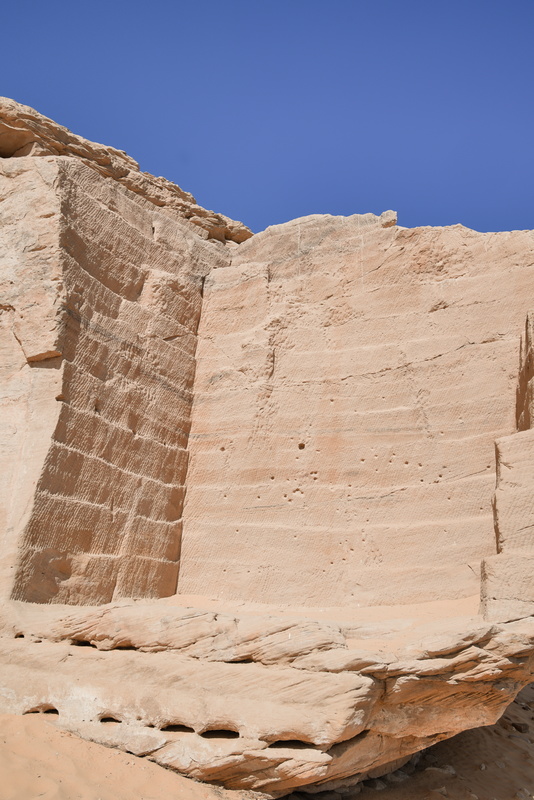
During the 18th Dynasty, limestone was replaced as a building material by sandstone, and much of it was quarried here. Akhenaten used a lot of this stone, although Horemheb recycled much of it in the backlash against Atenism.
Incidentally, Aten as the 'one god': does that mean what I thought it meant...? Wikipedia says, "The views of Egyptologists differ as to whether the religious policy was absolutely monotheistic, or whether it was monolatristic, syncretistic, or henotheistic."
Gosh, this is educational! I like to think of myself as reasonably knowledgeable, but WTF???
(All quotes from Wikipedia)
Monolatristic: "belief in the existence of many gods, but with the consistent worship of only one". Funnily enough, this is basically the Old Testament theology, but I never knew there was a specific word for it.
Syncretistic: "the blending of religious belief systems into a new system, or the incorporation of other beliefs into an existing religious tradition." Or in other words: well, there's only one god; well, except the others, but well, they aren't gods exactly, but we better not forget them I suppose... oh, it's so complicated, we just won't think too deeply about it. This exemplifies a lot of modern belief.
Henotheistic: "the worship of a single, supreme god that does not deny the existence or possible existence of other deities that may not be worshipped". This definition seems very similar to monolatrism, and indeed, "various scholars prefer the term monolatry to henotheism". I suggest you do your own research if this troubles you.
Regular readers will know that I can't promise you'll be any the wiser for reading my blogs, but I do guarantee you'll be better informed.
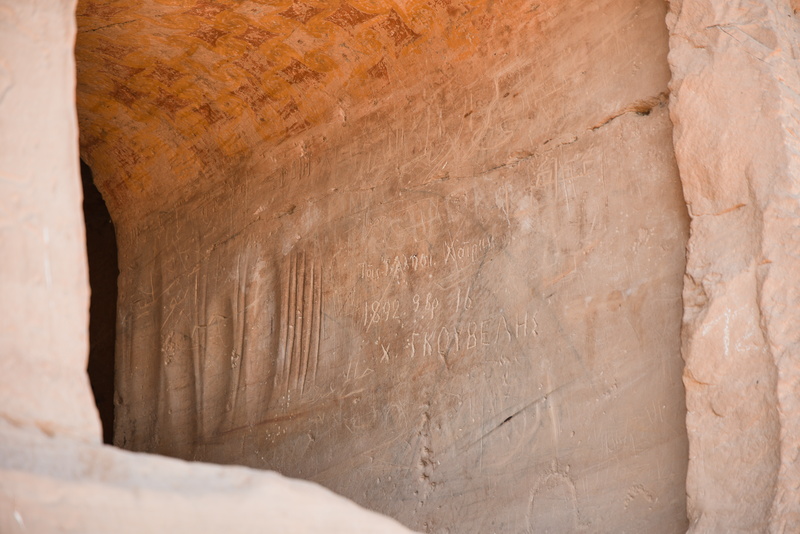
Although there are no massive tombs and temple complexes, there are many small rock-cut shrines, and note the gouge marks again.
They have also succumbed to modern graffiti, admittedly using the term 'modern' fairly broadly, to encompass at least the 19th Century. This one has the date 1892 and another I photographed has 1861; I make no claim that these are the earliest by any means.

Despite exposure and vandalism, ancient paintwork still remains.
Incidentally, the principle deity of Silsila is Sobek, the crocodile god. It seems a pity there are no crocodiles below the Aswan High Dam any more. Ok, granted it's more a theoretical loss than a practical one: I don't think any of us would be likely to go up to one and stroke it.
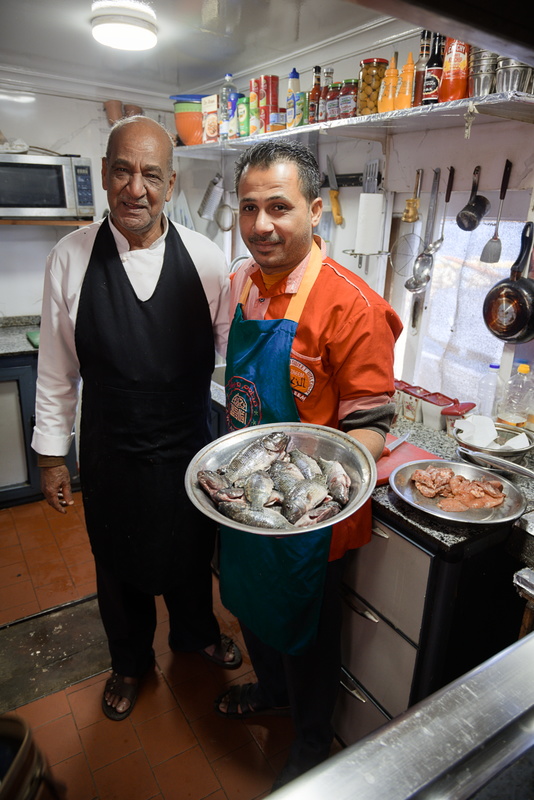
Look! Those are our fish, prepared for dinner this evening.
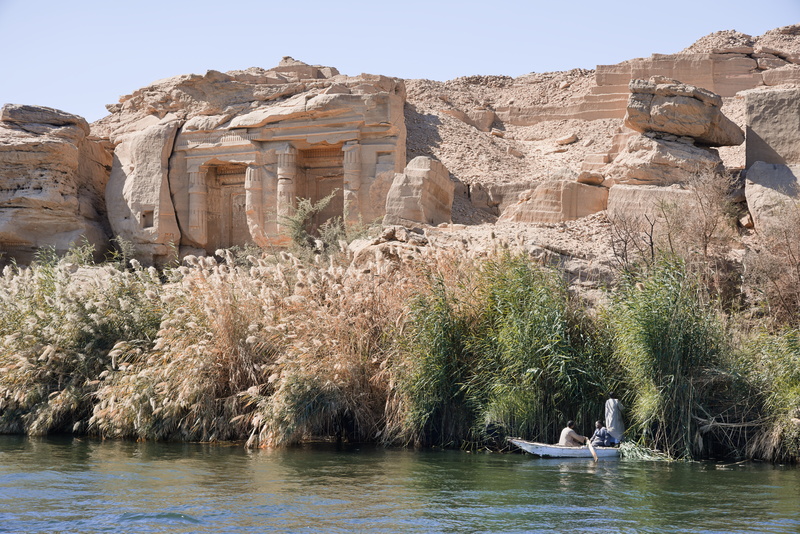
More royal shrines which we see as we sail past. They're part of the same complex but about twice as far upstream as we walked. Definitely a touch reminiscent of Petra, don't you think?
Next, we're going to get another look at local life. We're going to visit a box-maker in the town of Faris.
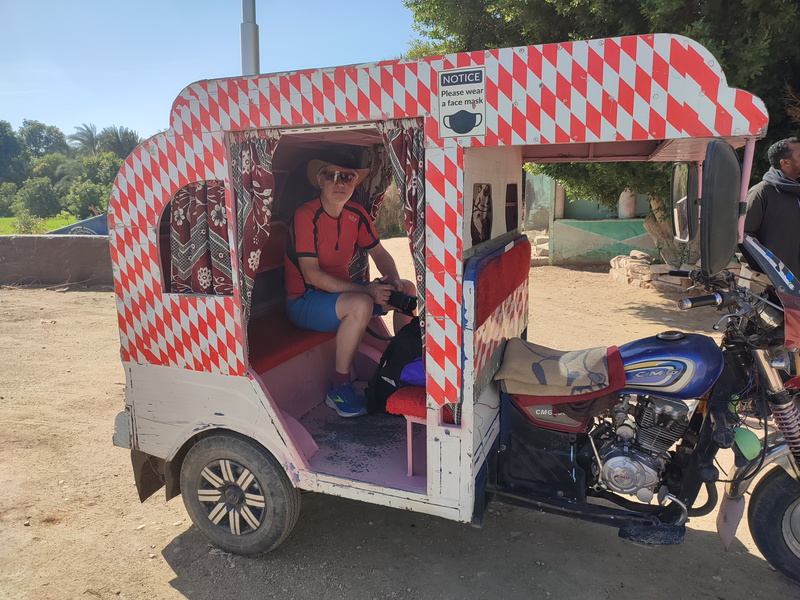
His location is a bit of a way from the dock, so we're taking a small fleet of tuk-tuks, all decked out in different styles and colours.
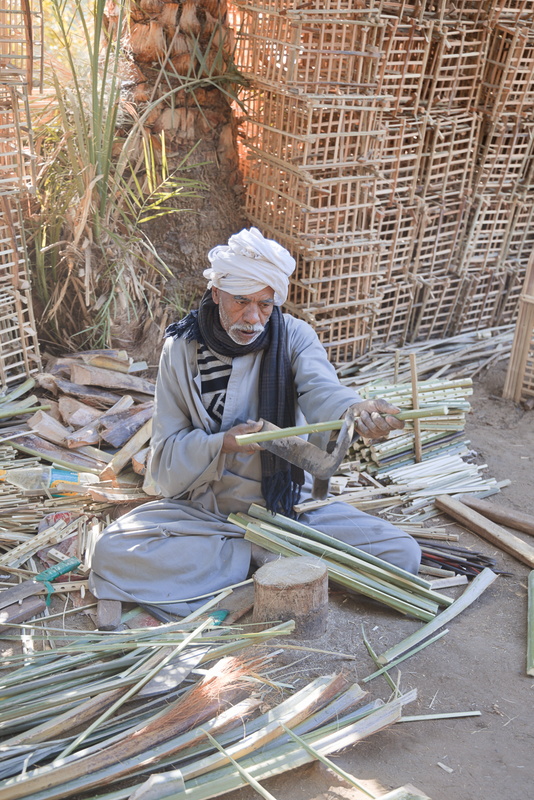
He starts by preparing lengths of reed. They're cut to uniform lengths, then some are punched with rows of holes, making them look a bit like a flute. He does it all with a combination of his hooked knife, a sharpened metal tube and a stick to bang it with.
After he's shown the basic technique, he invites us to join in. Sophie helps him make a box, then it's my turn.
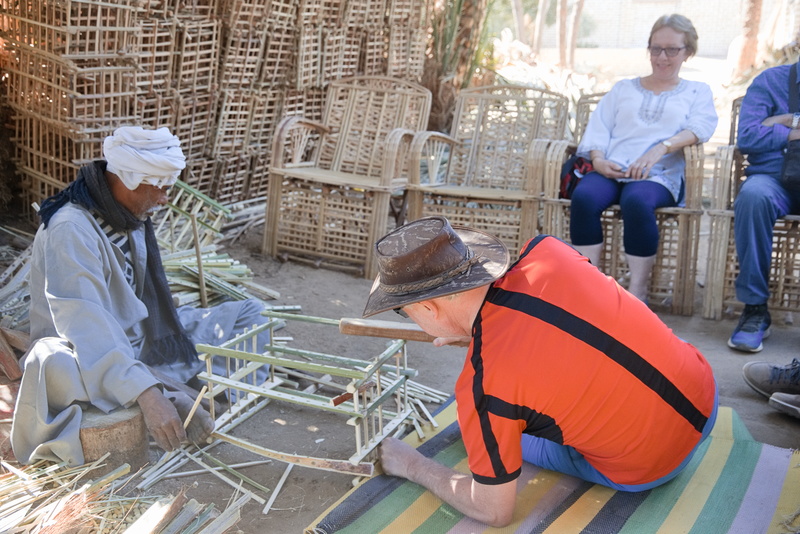
You can see the box taking shape now, and I'm using the low-tech hammer to insert the vertical pieces on one side.

And here's our completed box.
These boxes are made in huge numbers and are typically used to carry fruit such as mangoes to market. He also demonstrats making a much smaller version to hold a cardboard box of tissues!
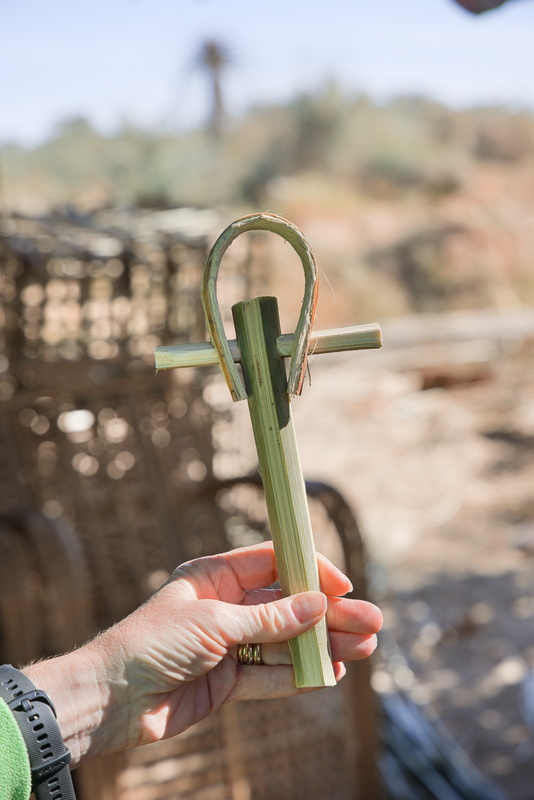
We are all given a little souvenir of our visit: an ankh symbol made using the same techniques.
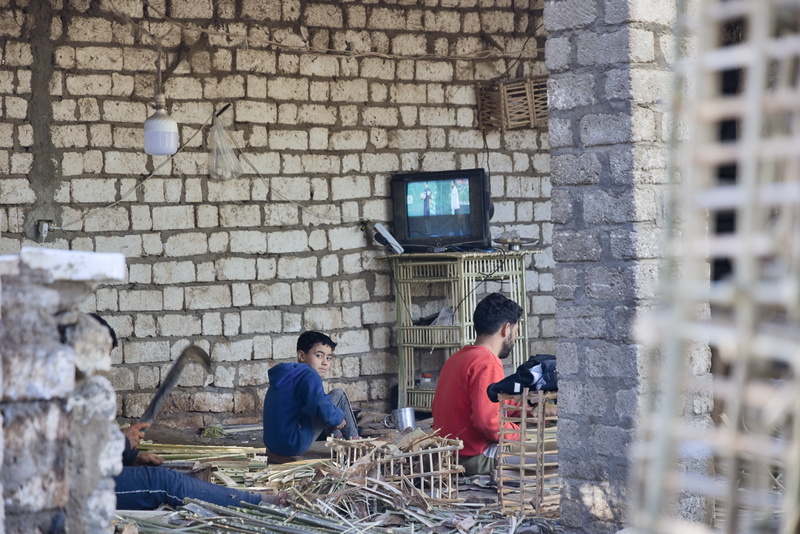
We're not convinced the whole family is working as hard.
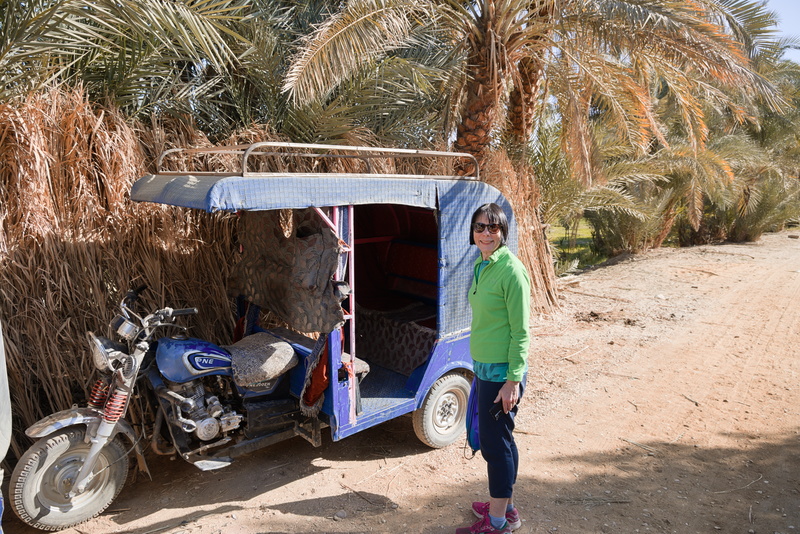
And then another tuk-tuk back to the boat.
We carry on sailing in the afternoon to tie up for the night at Kom Ombo. It's a pleasant few hours, but nothing different enough to need further pictures. And for dinner, of course, we have our loaves and fishes.
⬅ previous ⬆intro next ➡